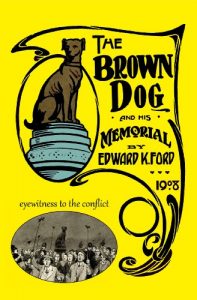In 1907, London medical students protested over a statue raised to a little brown dog. Bonfires burned late into the night. Large groups marched through the streets clashing with police. Gangs were arrested trying to pull down the memorial in midnight raids. Medical “hooligans” stormed meetings of their opposition. Behind this episode was an international conflict between pro-science and anti-vivisection groups. Tensions were high and growing. For some, physiology was growing in triumphal leaps and bounds. For others, science’s use of animals was rising too fast. Laws were ignored, and moral imperatives required action. In 1903, a celebrated libel case made London a hotspot for this debate. Anti-vivisectionists lost in court but used their new brown dog statue to win the propaganda war. Action provoked reaction for the next five years.
Edward K. Ford was an eyewitness. His pamphlet, published here as a complete facsimile, provides a rare on-the-ground account. It also includes key material on legal issues, as well as press and public reaction. His anti-vivisection perspective is plain. This remains essential reading for any study of the “brown dog affair,” anti-vivisection campaigns, and the history of science in society. Complete text of 1908 pamphlet.
Edward K. Ford was an eyewitness. His pamphlet, published here as a complete facsimile, provides a rare on-the-ground account. It also includes key material on legal issues, as well as press and public reaction. His anti-vivisection perspective is plain. This remains essential reading for any study of the “brown dog affair,” anti-vivisection campaigns, and the history of science in society. Complete text of 1908 pamphlet.






